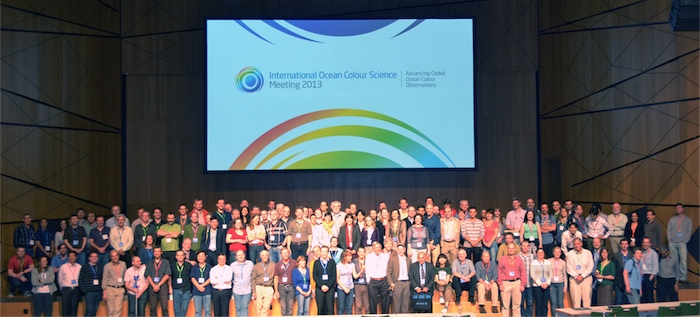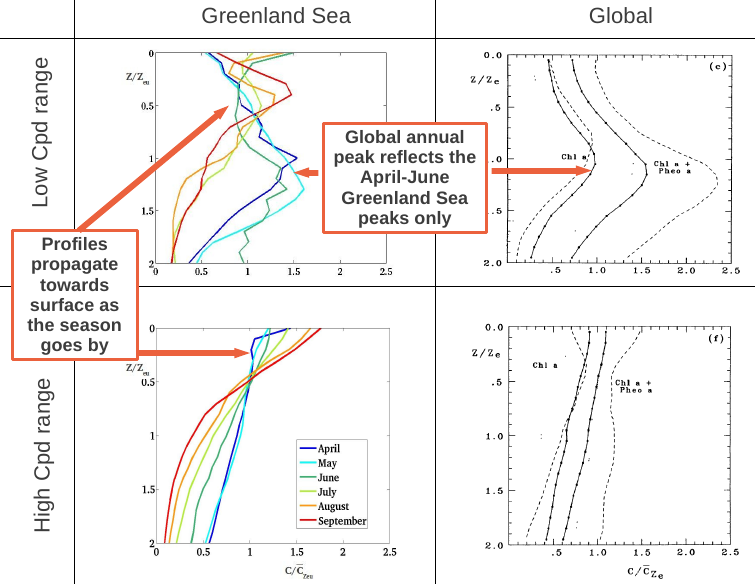

|
|
The IOCCG convened the first International Ocean Colour Science meeting in the City of Darmstadt, Germany, from 6-8 May 2013. EUMETSAT and NASA were the main sponsors and organizers of the meeting, with additional support being obtained from ESA and CNES which is gratefully acknowledged. In total, 244 scientists from 36 different countries participated in the highly successful three-day meeting, including representatives of all the major space agencies with an interest in ocean-colour radiometry, thus helping to bring together both the users and the providers of ocean-colour data for in depth discussions of detailed requirements for ocean-colour products and services
 One of the concrete outcomes of the first IOCS meeting is a comprehensive report of the proceedings of the meeting, which summarizes all agency talks, keynote presentations, and the outcomes of the various splinter sessions. It also provides a synthesis of the major recommendations from the 12 breakout splinter sessions, which can be used by space agencies and interested scientists to better understand the current state of the art. Many of these recommendations and key messages could be potentially followed up in the form of a workshop, so splinter session chairs were invited to submit proposals for follow-up workshops to pursue the goals and outcomes of their splinter sessions. These proposals will be evaluated by the IOCCG Executive Committee and a number of workshops will be supported by IOCCG in the coming months. All the presentations from the meeting are available at: iocs.ioccg.org/.
Due to the success of the first IOCCG Summer Lecture Series, and the overwhelming demand for the course, we are now starting to make plans for another Summer Lecture Series. The course will once again take place at the Laboratoire d’Océanographie de Villefranche (LOV) in Villefranche-sur-Mer, France, and will tentatively be held from 7 – 19 July 2014. Further updates will be made public as planning progresses.
Several new publications have been added to the IOCCG Recent References list, including a paper by Cherkasheva et al. (2013) which derives and describes the characteristic Greenland Sea Chl profiles, categorized according to the surface Chl concentration, with monthly resolution. The database consists of 1199 Chl profiles collected during fourteen Arctic expeditions with R/Vs Polarstern and Maria S Merian, combined with data from the ARCSS-PP database (Arctic primary production in situ database) for the years 1957-2010. The derived Gaussian approximations of the profiles generally reproduce the magnitude and position of the Chl maximum, resulting in an average 4% underestimation in total Chl (and 2% in rough primary production estimates) when compared to in-situ estimates. This is a major improvement compared to the total Chl values obtained from Morel and Berthon (1989) profiles (14% overestimation), or uniform profiles. The mathematical approximations are to be used as the input to the satellite-based primary production models that estimate primary production in the Arctic regions.
.  Left: Greenland Sea monthly mean Chl profiles categorized according to low (top) and high (bottom) Chl within the surface layer (Cpd). Right: profiles estimated from global relationships (click to enlarge). In another new paper by Melin et al. (2013) the aerosol products derived from the SeaWiFS, MODIS-Aqua and -Terra ocean colour missions are compared with field measurements from globally distributed AERONET sites. Validation statistics are found to be consistent for the three missions. The median absolute relative difference between SeaWiFS and AERONET aerosol optical thickness, τa, is approximately 20% at all bands, while it is slightly higher for both MODIS products (between 20% and 28%). This is associated with a larger relative bias (median of relative differences between satellite and AERONET τa), of the order of +15% for these missions. With respect to previous processing versions, a noticeable improvement is seen in the representation of the spectral dependence of τa. The bias found for the Ångström exponent varies from -0.08 to +0.13 for the three missions. Acknowledging the fact that the products associated with the considered ocean colour missions do not cover the upper range of aerosol optical thickness, the validation statistics obtained for these products appear at least as good as those obtained for satellite missions dedicated to aerosol retrievals.
The WASI (Water Colour Simulator) tool for the simulation of optical properties and light field parameters of deep and shallow waters has been extended by the WASI-2D module, which can process atmospherically corrected images from both space-borne and airborne sensors. Data analysis is done by inverse modeling. The provided database covers the spectral range from 350 to 1000 nm in 1 nm intervals, and can be exchanged easily to represent the study area of choice. The executable program, including user manual, can be downloaded from the IOCCG website. See the recent publication by Peter Gege for further information on WASI-2D.
Several new positions have been added to the Employment Opportunities section of the IOCCG website including post-doctoral research opportunities in Cape Town (South Africa), University of South Florida (USA), Université du Littoral-Côte d’Opale and the Laboratoire d’Océanologie et de Géosciences (France) and Masdar Institute, Abu Dhabi (UAE). See details on the IOCCG website at www.ioccg.org/employment.html.
|
NASA's OBPG has reprocessed the NASA ocean colour evaluation products from NPP-VIIRS to version 2013.1. The primary purpose of the reprocessing was to update the temporal calibration with an improved instrument degradation model derived from the latest solar diffuser measurements. The primary impact is to reduce an apparent upward drift in the blue bands. Details are posted at
The OBPG has detected significant calibration-related artifacts in the most recent MODIS-Aqua ocean colour products resulting from residual mirror-side differences in the MODIS-Aqua instrument calibration. The MODIS Calibration Support Team (MCST) is working on a solution and NASA anticipates a partial reprocessing of MODIS-Aqua ocean colour in the coming month(s). In the interim they will likely implement a discontinuous statistical correction to reduce the artifacts in forward stream products.
A full mission reprocessing of MODIS-Terra ocean colour is now underway: approximately a million files (2000-2013) have been processed to Level-2 and are available on-line. The final Level-3 binning process is now being done and should be completed shortly. Note that the latter period of MODIS-Terra now relies on MODIS-Aqua for cross-calibration corrections. Given the issues with MODIS-Aqua in 2013, the quality of MODIS-Terra in the 2013+ period is also limited, and subsequent updates to the 2013+ period for both missions are anticipated. Further details can be found on NASA's Ocean Color Forum.
NASA recently announced that ALL SeaWiFS (OrbView-2) data that were collected during the mission (September 1997-December 2010) in GAC, LAC or HRPT format is now in the public domain. The NASA OceanColor website has been updated accordingly.
The Sentinel-3A satellite is due for launch at the end of 2014. As part of the mission preparation activities, a Sentinel-3 Validation Team (S3VT) has been established by ESA and EUMETSAT to assist in the scientific validation of mission products. The aim of the S3VT is “To engage world-class expertise and activities, through mutual benefit collaboration, that support the implementation of the Sentinel-3 validation activities and ensure the best possible outcomes for the Sentinel-3 mission” with the objective “To provide independent validation evidence, experimental data and recommendations to the S3 Mission”. Submissions to the S3VT Call for collaborative Validation Proposals have been reviewed by a joint ESA-EUMETSAT panel. The call was extremely successful with 80 proposals from 20 countries (including non-ESA member states) covering all S3 domains. The First S3VT Workshop will be held 26-29th November 2013 at ESA/ESRIN. The meeting is planned to consist of plenary information talks to coordinate the S3VT, sub-group working sessions, a poster session and a plenary review.
|
|
Material for possible inclusion in the IOCCG Newsletter should be submitted to the Project Scientist, Dr. Venetia Stuart
Subscription to the IOCCG Mailing List. Participants receive a brief summary of the IOCCG Newsletter by e-mail (quarterly), as well as hard copies of IOCCG Reports as, and when, they become available.
|
|
|
|